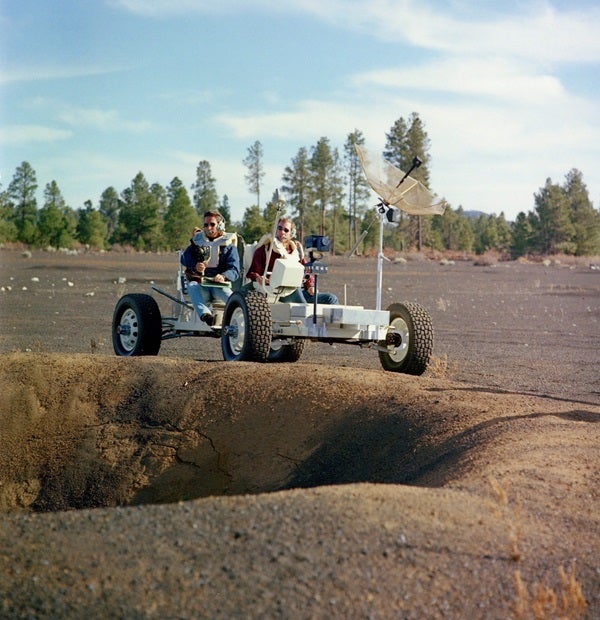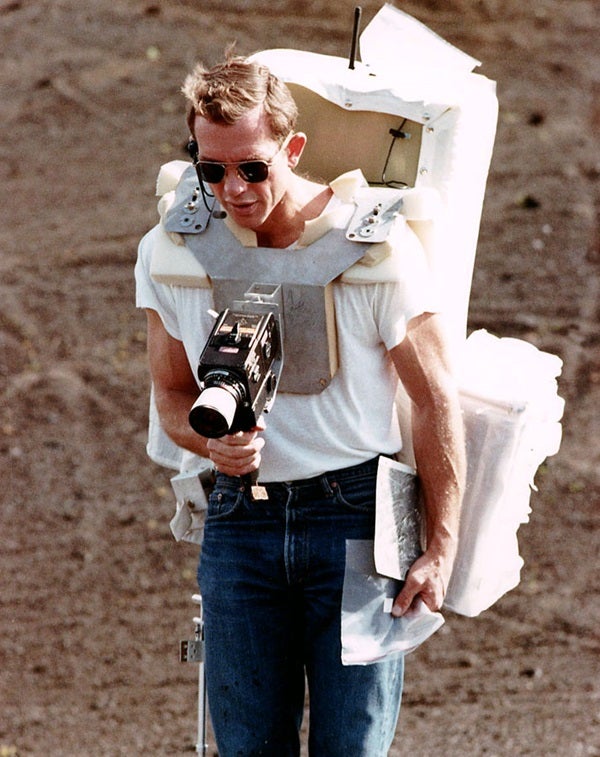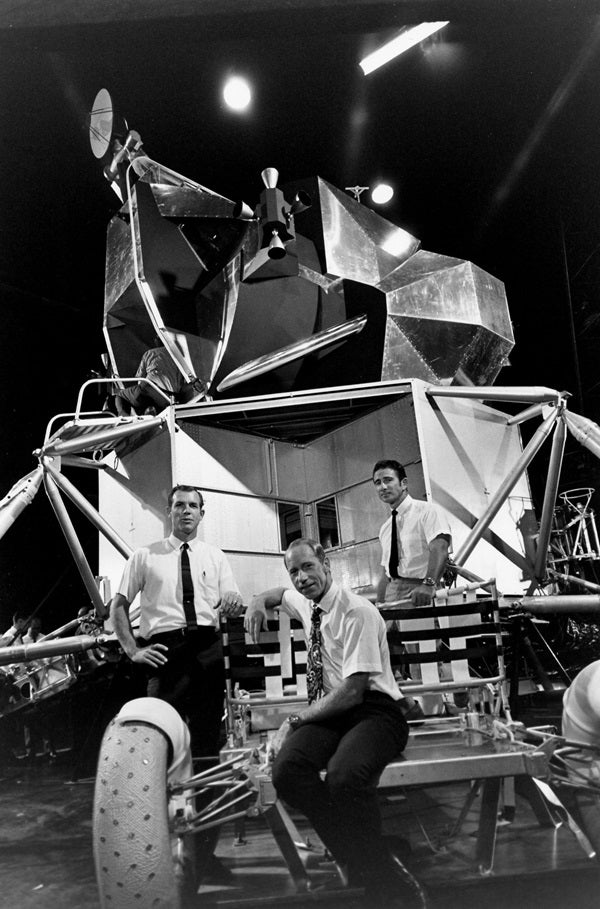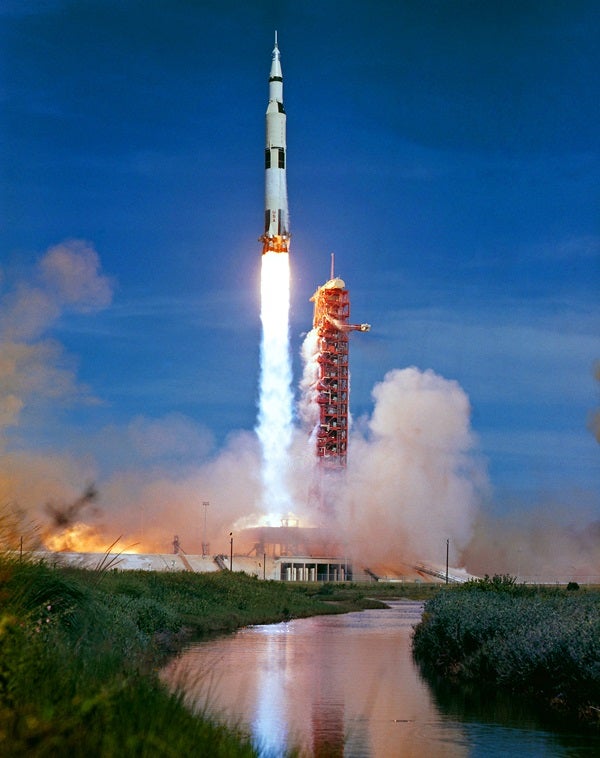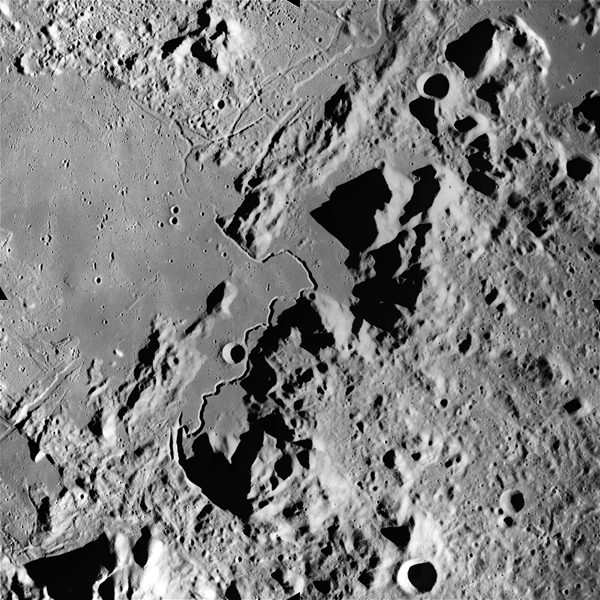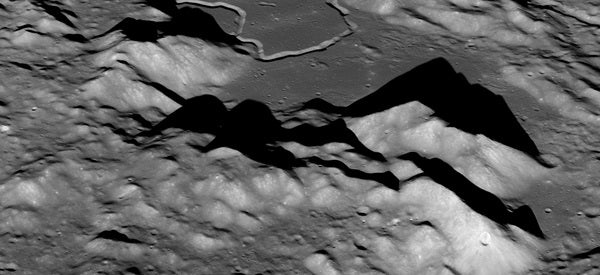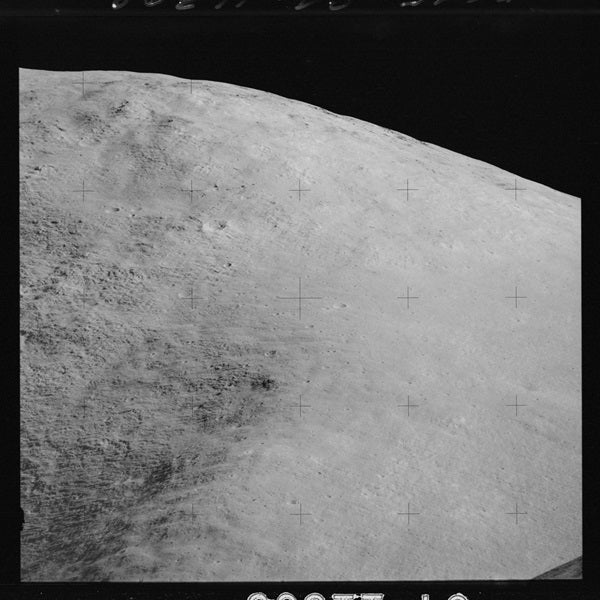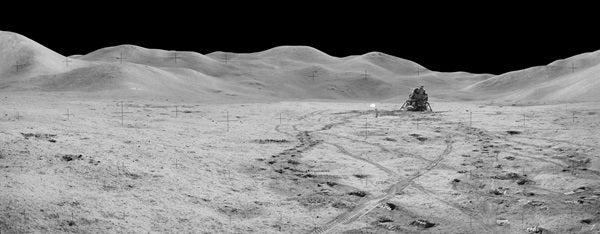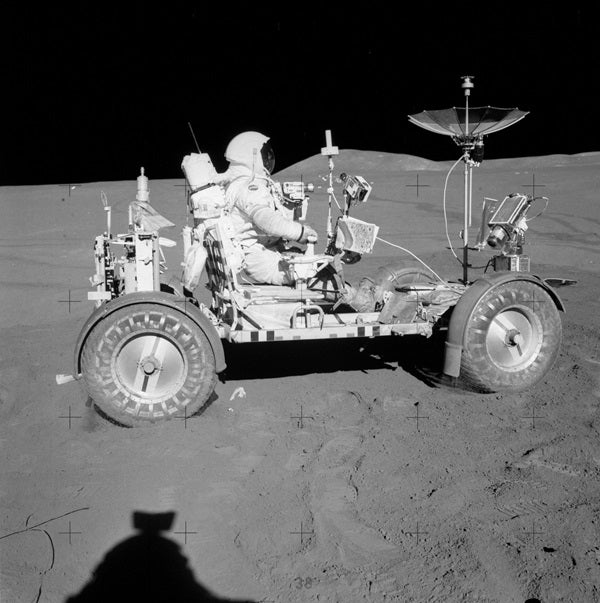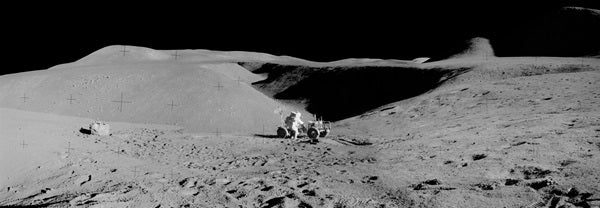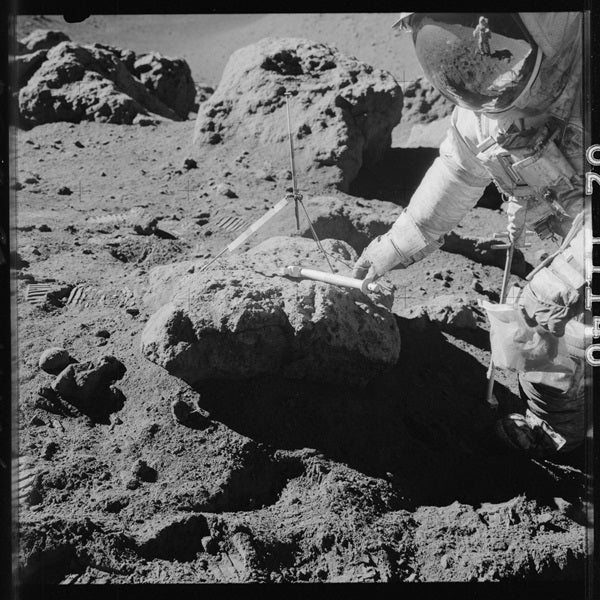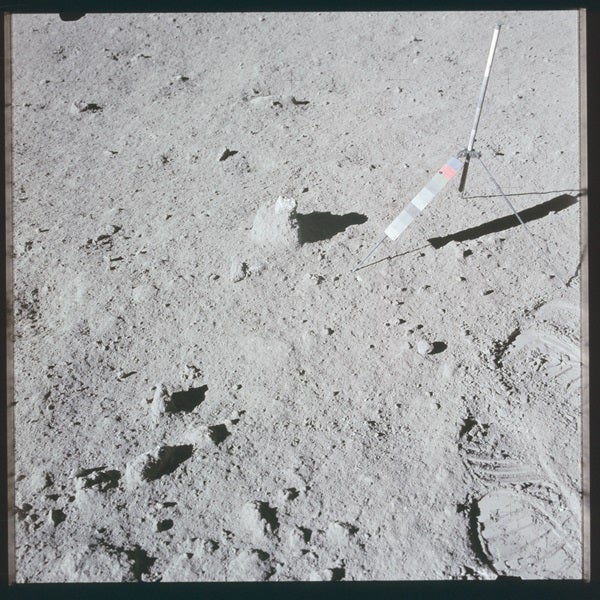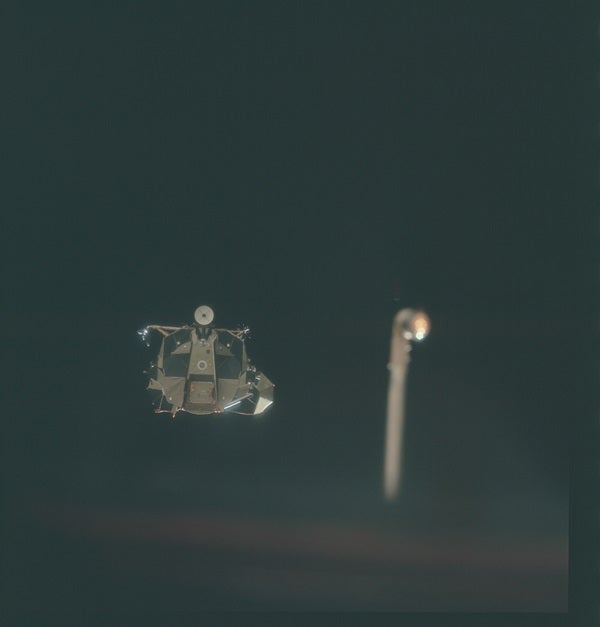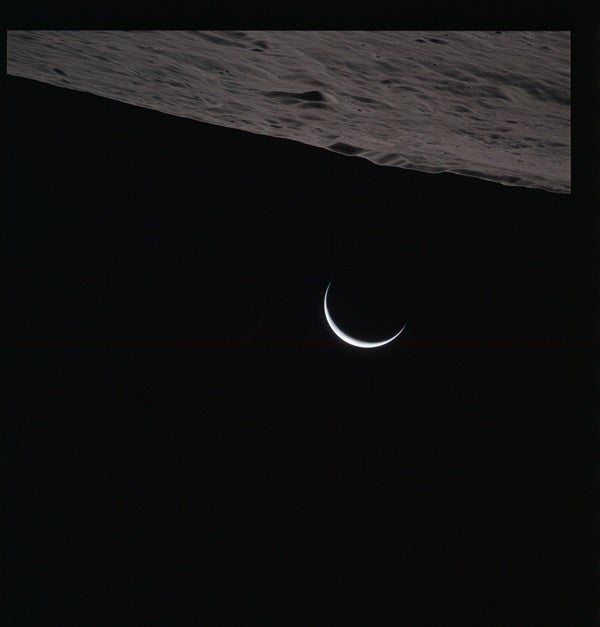After three successful lunar landings — and the “successful failure” of Apollo 13 — NASA was ready to swing for the scientific fences. The previous landings had been considered test flights, H series missions in NASA parlance, intended to show that landing on the Moon could be done. Apollo 15 would be the first of the J series, with more ambitious scientific objectives.
To meet those goals, Apollo 15’s crew brought all kinds of new and upgraded tools: a percussive drill to collect core samples and plant heat probes; brand-new 500mm telephoto lenses; and, most famously, the “Moon buggy” called the Lunar Roving Vehicle (LRV). Built by Boeing, the rover promised to dramatically expand the range of the astronauts’ field expeditions.
After the precision landings of Apollo 12 and 14, NASA also got aggressive with its choice of landing site, the Hadley Plain. This roughly 6-mile-wide (10 kilometer) clearing was hemmed in by the Apennine Mountains and bordered by the 0.6-mile-wide (1 km) meandering canyon called Hadley Rille, which may have been created by volcanic activity. It was a spectacular setting with great geological potential.
Commander David Scott, a NASA veteran, was a perfect match for this mission. More than any other moonwalker to date, Scott embraced the role of field geologist and sought to learn as much as he could under the tutelage of Caltech geologist Leon Silver. His choice of name for the Command Module (CM) reflected his scientific enthusiasm: Endeavour, after the vessel that carried British explorer Captain James Cook on his first scientific voyage.
Scott was joined on the mission by Lunar Module Pilot James Irwin and Command Module Pilot Alfred Worden, two first-time astronauts who’d joined NASA’s corps in 1966. The trio attacked their mission with gusto and a sense of awe that lives on in the transcripts and audio recordings — and here, in this story.
Apollo 15 lifted off exactly on schedule July 26, 1971, at 9:34 A.M. EDT, keeping to a tight mission timeline that would ensure a favorable Sun angle when Scott and Irwin arrived at the Apennine Mountains on their landing approach. As the Saturn V rocket climbed out over the Atlantic, Scott checked in with his rookie crewmates.
Scott: How we doing, Al?
Worden: We’re doing fine; 63 miles [altitude].
Scott: Good.
Irwin: Everything looks good over here.
Scott: OK.
Worden: Just — looks just about a hundred feet per second down on the H-dot [climb rate], but everything else looks fine.
Scott: OK, I got the big fireball going by at staging. I don’t know whether you saw it or not. That beauty really goes.
Worden: Yes.
Gordon Fullerton, Capsule Communicator (CapCom): 15, Houston. At four [minutes], the guidance has converged. The CMC [Command Module Computer] is go and everything looks good.
Scott: OK, Gordo. Looks good up here.
Irwin: Man, I got the Moon in my window.
Scott: Yes, sir. It’s out there.
The three-day journey of Endeavour and the Lunar Module (LM) Falcon to lunar orbit was a calm one, interrupted only by having to troubleshoot a short circuit in the firing switch for the Service Module (SM) thrusters. On the afternoon of July 29, the crew slipped into lunar orbit with a perfectly executed braking burn. As they began their first revolution, the crew tried to relay descriptions to Houston of the geological features they were seeing.
Scott: And, you know, as we look at all this after the many months we’ve been studying the Moon and learning all the technical features and names and everything, why — when you get it all at once, it’s just absolutely overwhelming. There are so many different things down there and such a great variety of landforms and stratigraphy and albedo, that’s it’s hard for the mental computer to sort it all out and give it back to you. I hope over the next few days, we can sort of get our minds organized and get a little more precise on what we’re seeing. But I’ll tell you, this is absolutely mind-boggling up here.
Karl Gordon Henize (CapCom): Gentlemen, I can well imagine that a foreign planet must be a weird thing to see.
As Apollo 15 continued in its orbit just 70 miles (113 km) or so above the lunar surface, the Apennine Mountains began to appear on the horizon — the very mountains Scott and Irwin would have to negotiate the next day.
Scott: And, Karl. We’re approaching the Apennine Mountains, and that is indeed a spectacular view.
Henize: Roger.
Worden: Sure is, Karl. No question about those mountains being there and where we’re at with them.
Henize: They stand up on your horizon, do they?
Worden: Yes; tremendous relief as we approach the mountain, Karl. […]
Scott: Houston, as we cross out of [Mare] Serenitatis into the Apennines, why, it’s just — unreal. You know, those are very poor descriptive terms, but the — the mountains jut up […] here in great relief. I’m sure the guys who’ve been here before can probably sit down over a cup of coffee and tell you. But the relief is really pervasive.
Henize: You’re the first man to fly over this mountain range, Dave. I guess pretty soon you’re going to be over the — over the landing site, aren’t you?
Scott: Roger. But I’m afraid it’ll be dark today.
Henize: That’s right.
Scott and Irwin got their chance to see it the next day, as lunar dawn broke over the Hadley Plain. As they descended in Falcon, they soared over the Sea of Serenity, heading for the mighty Apennines. Their landing site, the Hadley Plain, was tucked against the other side of the range. To get there, they descended at a much steeper angle than any previous Apollo mission, cleared a 12,000-foot-high ridgeline (3,650 m), and shot the gap between Mount Hadley (13,000 feet [4,000 m]) and Mount Hadley Delta (11,500 feet [3,500 m]).
Edgar Mitchell (CapCom): Falcon, Houston. We expect you may be a little south of the site, maybe 3,000 feet.
Irwin: OK. Coming up on 8,000 [feet in altitude].
Scott: OK.
Irwin: 7,000 feet.
Through most of the powered descent, the LM was flying on its side, braking with its engine facing forward. As they passed 7,000 feet (2,130 m), the LM rotated to an upright position, allowing the pair to see their surrounding landscape out the windows. Although they’d done extensive simulator training, that didn’t prepare them for the awesome sight of Mount Hadley Delta towering nearly a mile (1.6 km) above them. That view also helped Scott orient himself and immediately correct the computer’s landing trajectory with a hard roll.
Irwin: P64! [Program 64 was the guidance computer’s landing program.]
Scott: OK.
Irwin: We have LPD. [The Landing Point Designator mode allowed Scott to alter the computer’s landing target.]
Scott: LPD. Coming right.
The rest of the descent was all business as Irwin called out LPD and altitude information to Scott.
Irwin: You’re 200 [feet], minus 11 [feet descent rate]. 150, minus 7. Minus 6. 120 feet, minus 6.
Scott: OK, I’ve got some dust.
The descent continued, until the LM fell the final few feet to the surface, landing with a hard jolt.
Irwin: Contact! Bam!
Scott: OK Houston, the Falcon is on the Plain at Hadley.
Mitchell: Roger, roger, Falcon. [Applause in the background.]
Irwin: No denying that. We had contact!
In the minutes after touchdown while Houston ran some system checks, Scott and Irwin bantered with each other.
Scott: Hey, from now on, we’re Hadley Base. OK?
Irwin: OK, OK. Let me write that down. [Pause.] Doggone, this one-sixth [gravity] is about as bad as zero. Things really float around.
Scott: Yes. […]
Irwin: Man, we really touched down.
Scott: One foot per second.
Irwin: I know it, but it felt — felt like we were coming down about 5. [Laughs.] I couldn’t believe it.
A couple of hours later, the astronauts popped open the LM top hatch so that Scott could conduct a short visual survey of the site, giving him a first look at the stunning landscape. For 10 minutes, he gave a detailed description of what he saw to Mission Control, with the geologists in the back room — where non-flight controller support staff huddled — hanging on his every word.
The next day, the pair emerged from the LM for their first proper extravehicular activity (EVA).
Scott: OK, Houston. As l stand out here in the wonders of the unknown at Hadley, I sort of realize there’s a fundamental truth to our nature. Man must explore. And this is exploration at its greatest.
The first item on the agenda was to unload the rover, unfold it, fire it up, and give it a test drive.
Scott: OK, looks like the brake’s on, reverse is down, so I’ll see if I can’t hop in it. [Pause.] That’s a reasonable fit.
Joe Allen (CapCom): OK, Dave. And buckle up for safety here.
Scott: Oh, yes. OK, safety belts on. […] OK, got a detent; we’re moving.
Allen: Extraordinary.
Scott: Hey, Jim, you can probably tell me if I’ve got any rear steering.
For greater maneuverability, the rover’s front and rear axles were both capable of turning.
Irwin: Yes, you have rear steering.
Scott: OK. But I don’t have any front steering.
Despite cycling some of the rover’s circuit breakers, they couldn’t activate front steering. Nevertheless, they took off to the southwest using only rear steering, heading toward the rim of the Hadley Rille. They followed the canyon around to their first station — Elbow Crater, about 1.7 miles (2.7 km) from the LM, hitting top speeds of 7.5 mph (12 km/h). But they couldn’t help but notice interesting samples as they sped across the terrain.
Scott: It feels like we need the seat belts, doesn’t it, Jim?
Irwin: Yes, really do. […] Boy, it really — really bounces, doesn’t it?
Scott: Well, I think — there’s sort of a — the rear end breaks out at about 10 to 12 clicks [km/h].
Allen: Roger, Dave, it sounds like it’s like steering a boat, with the rear steering and the rolling motion.
Scott: Yes, that’s right. It sure is. Hey, here’s a good fresh one [rock] right there —
Irwin: Yes, I was looking at that one at 1 o’clock to us right now. Very fresh angular block of lighter albedo material on the south rim. […]
Scott: [Laughs.] Man, this is really a rocking-rolling ride, isn’t it?
Irwin: Never been on a ride like this before.
Scott: Boy, oh, boy! I’m glad they’ve got this great suspension system on this thing. Boy.
The pair pulled up to Elbow Crater and began collecting samples, depositing them into collection bags. Scott and Irwin could barely contain their enthusiasm, even when Allen gently directed them to the next stop on their itinerary, St. George Crater, about 2,000 feet (600 m) away at the base of the Apennine Front.
Scott: OK, Joe, you want us to press on up to St. George [Crater]?
Allen: That’s affirmative, guys. Move on.
Irwin: OK, Dave.
Scott: OK. We’re on the way. Oh, boy! This traveling! This is great sport, I’ll tell you.
Irwin: The sandpile [training area at Kennedy Space Center] was never like this.
Scott: Yeah, man. I wish we could just sit down and play with the rocks for a while. Look at these things! They’re shiny, sparkly! Look at all these babies here — gosh! Man!
Irwin: Come on, Dave. There’ll be lot of them, let’s get back.
Scott: Can’t resist it. [Let’s] go find something neat in St. George.
And they did.
Scott: There is one boulder! Very angular, very rough surface texture. Looks like it’s partially … Well, it’s got glass on one side of it with lots of bubbles, and they’re about a centimeter across. And one corner of it has got all this glass covering on it. Seems like there’s a linear fracture through one side. It almost looks like that might be a contact — it is! Within the rock. It looks like we have maybe a breccia [a collection of rock fragments cemented together] on top of a crystalline rock. It’s sort of covered with glass — I can’t really tell. […]
Irwin: It looks fairly recent, doesn’t it, Dave?
Scott: Yes, it sure does! It sure does! And I can see underneath the upslope side, whereas, on the downslope side, [the soil]’s piled up.
That suggested the rock had been blown out by a meteorite impact and dug into the soil as it came to rest.
Scott: Boy, that is really something. Hey, let’s get some good pictures of that before we disturb it too much. […]
Allen: Roger, Dave and Jim. […] And it probably is fresh; probably not older than three and a half billion years.
Scott: Can you imagine that, Joe? Here sits this rock, and it’s been here since before creatures roamed the sea in our little Earth.
Next, Scott tried to break off a chunk of it.
Scott: OK. Let’s try the old hammer. Bring me a couple of bags here, old buddy.
Irwin: Yeah. Standing by.
Scott began hammering away at the boulder.
Scott: [Laughs.] Man.
Irwin: Get a good one?
Scott: No.
Irwin: Pull hard.
Scott: Ah, is that hard!
Irwin: Well indurated.
Scott: Wowee. Ah! Ah! [The sound of hammer blows are audible, conducted through his suit.] […]
Irwin: Hey, you’re knocking off a few fragments.
Scott: Yeah.
Irwin: Probably the best you’re going to be able to do.
Scott: Ah! After all that instruction I got.
Irwin: Dave, I think, up on top here, if you hit it, it will break.
Scott: Yeah, right here?
Irwin: Right there. Yeah. [Pause.] Yeah, it’s coming loose. [Pause.] Yeah.
Scott: There it is, I got it. Oh, oop. [Softly.] There. That’s it, right there.
Irwin: Boy, that rock is really ready to roll!
Scott: There it is.
Irwin: Yeah, good show.
The next day started auspiciously: The rover’s front steering was suddenly — inexplicably — functional. This made the drive to Spur Crater, some 2.1 miles (3.4 km) south, much easier for Scott.
Geologists hoped that by exploring the lower slopes of the Apennines, the astronauts might encounter ancient samples dating to the era before the Moon’s major basins, or mare, had been filled with lava. This primordial material could shed light on the origins of both the Moon and Earth.
They were rewarded: Inside the rim of Spur Crater, they spotted a gleaming rock that became the most famous Apollo sample of all, dubbed the Genesis Rock.
Allen: Dave and Jim […] is it your impression that you are sampling on the ejecta blanket of Spur Crater, now?
Scott: Yes, sir — probably from the deepest part, because we’re right on the rim.
Allen: Sounds good!
Scott: OK, [bag number] 195. Wouldn’t you agree with that, Jim?
Irwin: Yeah. Yes, sir.
Scott: OK. Now let’s go down and —
Irwin: Get that unusual one?
Scott: Get that unusual one. [Pause.] Here’s some dense … And there’s another unusual one. Look at the little crater here, and the one that’s facing us. There is a little white corner to the thing. […] OK, there’s a big boulder over there down-Sun of us, that I’m sure you can see, Joe, which is gray. And it has some very outstanding gray clasts and white clasts, and oh, boy, it’s a beaut! We’re going to get ahold of that one in a minute.
Irwin: OK, I have my pictures, Dave.
Scott: OK, let’s see. What do you think the best way to sample it would be?
Irwin: I think probably… Could we break off a piece of the clod underneath it? Or I guess you could probably lift that top fragment right off.
Scott: Yeah. Let me try.
As Scott leaned into it, he thought it was a white clast breccia — until a reflection caught his eye, and he realized it was something much rarer.
Scott: Yeah. Sure can. And it’s a — a white clast, and it’s about —
Irwin: Oh, man!
Scott: Oh, boy!
Irwin: I got —
Scott: Look at that.
Irwin: — Look at the glint!
Scott: Ah…
Irwin: Almost see twinning [a symmetrical crystal pattern] in there!
Scott: …Guess what we just found. [Laughs.] Guess what we just found! I think we found what we came for.
Irwin: Crystalline rock, huh?
Scott: Yes, sir. You better believe it.
Allen: Yes, sir.
Scott: Look at the plage [plagioclase, a type of crystalline formation] in there.
Irwin: Yeah.
Scott: Almost all plage.
Irwin: [Garbled.]
Scott: As a matter of fact — [laughs] Oh, boy! I think we might have ourselves something close to anorthosite, ‘cause it’s crystalline, and there’s just a bunch… It’s just almost all plage. What a beaut.
Irwin: That is really a beauty. And, there’s another one down there!
Scott: Yeah. We’ll get some of these.
Allen: Bag it up!
Scott: Ah! Ah!
Irwin: Beautiful.
Scott: Hey, let me get some of that clod there. No, let’s don’t mix them. Let’s make this a special — why — I’ll zip it up.
Irwin: OK.
Scott: Make this bag, 196, a special bag.
Allen: Yes, sir.
Scott: Our first one. [Pause.] Don’t lose your bag now, Jim. [Irwin: laughs.] Oh, boy!
The Genesis Rock was an instant sensation. Although it was not, as first thought, a piece of primordial lunar crust, at 4.1 billion years old, it was one of the oldest samples found during the entire Apollo program.
Over the course of the first two days, Scott and Irwin encountered persistent problems using the all-new power drill, struggling to exert enough pressure for it to make headway when planting probes to measure the Moon’s internal heat. The issues came to a head on the morning of their third day on the surface, when they were supposed to retrieve a core sample. Although they eventually succeeded, the delays forced them to cut their third EVA short and forgo exploring the North Complex of craters.
Nevertheless, all the mission’s science objectives had already been achieved. The astronauts capped their lunar exploration with a short jaunt in the rover over to the rim of Hadley Rille. The rover had more than proved its worth, covering 17.5 miles (28.2 km) over 18 hours and 37 minutes of EVA — a new duration record.
Shortly after returning to the LM, Scott and Irwin lit the engine of Falcon’s ascent stage and flew to a rendezvous with Endeavour and Worden, who had been keeping busy in lunar orbit with his own campaign of photography.
On the 10th day of the mission, Houston sprang a surprise over the radio — the voice of their geology tutor Leon Silver greeted the astronauts, kicking off the first and only direct conversation between a geologist and a crew during the Apollo missions.
Silver: Hey, Dave. You’ve done a lovely job. You just don’t know how we’re jumping up and down, down here.
Scott: Well, that’s because I happened to have had a very good professor.
Silver: A whole bunch of them, Dave.
Scott: That’s right. As a matter of fact, so many of them, it’s just hard to — hard to remember it all. But we sure appreciate all you all did for us in getting us ready for this thing. […] I just wish we had had more time, because, believe me, there is an awful lot to be seen and done up there.
Silver: Yes. We think you defined the first site to be revisited on the Moon. […]
Scott: I hope someday we can get you all up here, too. I think we really need to have some good professional geologists up here. As a matter of fact, good professional scientists of all disciplines, not only in lunar orbit, but right on the surface, because you all would just really have a field day, where — with your backgrounds and what you know. There’s just so much to be gained up here.
The crew completed one more task before they left lunar orbit: deploying a small, 78-pound (36 kilogram) probe that had tagged along in the SM. This “subsatellite” would carry out space physics experiments and take measurements of the lunar environment. Then they fired the SM’s engine to start their journey back to Earth.
The next day, Worden performed a brief EVA to retrieve film canisters from the SM’s cameras from his imaging campaign, clambering out of Endeavour and along handholds on the SM in the first ever deep-space spacewalk.
On Aug. 7, 1971, as Apollo 15 barreled into Earth’s atmosphere before splashing down at 3:45 P.M. CDT some 330 miles (530 km) north of Honolulu, the astronauts’ thoughts of the Moon melted away. On previous missions, moonset — the crews’ final glimpse of the Moon as it slipped over the horizon — was a highlight of reentry. But for the astronauts of Apollo 15, it was our home planet that caught their gaze.
Worden: Oh, that’s the Earth down there, baby.
Irwin: Can you see it?
Scott: Sure as hell can. Yes, siree, I hope to tell you. […]
Worden: Oh, yes. Hey — oh, man, are we moving, too! Son of a gun! Sheeoo!
Scott: Yes, indeedy. You ought to be able to see it out the — out the hatch window.
Worden: Oh my, I sure can. Sure a lot of mountains down there. How about that?
Irwin: S—, I think that’s Alaska out there. That would be right, wouldn’t it?
Worden: Yes. Keep an eye out for the Moon.
Scott: Yes, keep an eye out for the Moon.
Worden: We’ve done it. Oh, we’ve missed it. […]
Scott: Oh, Al —
Worden: We were too busy watching the Earth.
Scott: — why don’t you pay attention to what you’re doing there?
Worden: Too busy watching the Earth.

